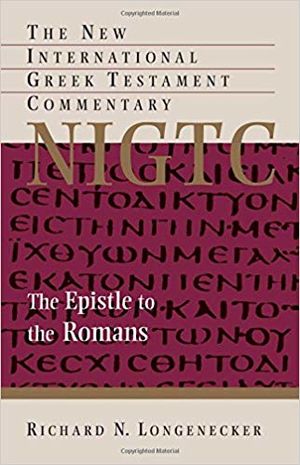The Epistle to the Romans ~ NIGTC (2016 Longenecker), book
Richard N. Longenecker, The Epistle to the Romans: A Commentary on the Greek Text (New International Greek Testament Commentary; Grand Rapids, MI: Eerdmans, 2016).
Abstract
"This highly anticipated commentary on the Greek text of Romans by veteran New Testament scholar Richard Longenecker provides solid scholarship and innovative solutions to long-standing interpretive problems. Critical, exegetical, and constructive, yet pastoral in its application, Longenecker's monumental work on Romans sets a course for the future that will promote a better understanding of this most famous of Paul's letters and a more relevant contextualization of its message."--Publisher description.
Contents
INTRODUCTION TO THE COMMENTARY -- 1.Romans vis-a-vis Paul's Other Letters -- 2.Major Critical Issues in the Study of Romans -- 3.Distinctive Exegetical Treatments of the Present Commentary -- 4.Prominent Thematic Features of the Present Commentary -- 5.The Greek Textual Tradition of Romans -- COMMENTARY PROPER -- The Opening Sections of the Letter -- I.Salutation (1:1-7) -- II.Thanksgiving (1:8-12) -- The Body Sections of the Letter -- A.Body Opening -- III.A Brief Introduction to Paul's Protreptic Message (1:13-15) -- B.Body Middle -- IV.Section I Righteousness, Faithfulness, and Faith (1:16 -- 4:25) -- Part One of Section I (1:16 -- 3:20) -- 1.Thesis Statement on Righteousness, Faithfulness, and Faith (1:16-17) -- 2.God's Wrath against Human Rebellion, Idolatry, and Debauchery (1:18-32) -- 3.God's Condemnation of All Who Sin Is Just and Impartial (2:1-16) -- 4.Denunciations of Jews and Jewish Failures (2:17-29) Note continued: 5.The Situation of the Jews before God (3:1-20) -- Part Two of Section I (3:21 -- 4:25) -- 6.The Thesis Statement Developed, Supported, and Elucidated (3:21-31) -- 7.The Example of Abraham with Respect to Righteousness and Faith (4:1-24) -- 8.Concluding Early Christian Confessional Statement (4:25) -- V.Section II: Peace, Reconciliation, and Life "in Christ" (5:1 -- 8:39) -- 1.Transitional and Thesis Passage on "Peace" and "Reconciliation" (5:1-11) -- 2.The Universal and Foundational Redemptive Story: What Jesus Christ Effected vis-a-vis What Adam Brought About (5:12-21) -- 3.Three Important Questions, with an Interjected Illustration and Statement (6:1 -- 7:13) -- Question One "Should We Continue in Sin So That Grace May Increase?" (6:1-14) -- Question Two "Should We Sin Because We Are Not under the Law but under Grace?" (6:15-23) Note continued: Interjected Illustration on the Extent of the Authority of the Mosaic Law and Statement regarding a Christian's Freedom from the Law (7:1-6) -- Question Three "Is the Law Sin?" (7:7-13) -- 4.Soliloquy on the Tragic Plight of Those Who Attempt to Live Their Lives Apart from God, "under Their Own Steam" (7:14-25) -- 5.No Condemnation and New Life for People "in Christ Jesus" and Therefore "in the Spirit" (8:1-17) -- 6.Life in the Spirit, Both Personal and Universal and Both Present and Future: A Life of Suffering and Glory (8:18-30) -- 7.A Triumphal Affirmation of God's Vindication, Care, and Eternal Love for People "in Christ Jesus," with Early Christian Confessional Materials Incorporated (8:31-39) -- VI.Section III The Christian Gospel vis-a-vis God's Promises to Israel (9:1 -- 11:36) -- 1.Introduction: Paul's Great Desire for his People, Israel's Heritage, and Israel's Messiah, with a Closing "Amen" (9:1-5) Note continued: 2.Part I of Paul's Exposition: God's Promises Given to "the Remnant" of Israel, with OT Passages Cited in Support (9:6-29) -- 3.Part II of Paul's Exposition: Israel's Present Failure and the Gentiles Blessed, with OT Passages Cited in Support (9:30 -- 10:21) -- 4.Part III of Paul's Exposition: The Course of God's Salvation History: A Remnant within Israel, a Remnant among the Gentiles, the Salvation of "All Israel," and God's Mercy on All People (11:1-32) -- 5.Doxology: A Hymn of Praise to God for His Wisdom and Knowledge, Incorporating Early Christian Confessional Materials (11:33-36) -- VII.Section IV Exhortations, Both General and Specific (12:1 -- 15:13) -- 1.Opening Appeals and a Statement regarding Dedication, Commitment, and Discernment (12:1-2) -- 2.Appeal for Humility and Mutual Service among Believers in Jesus (12:3-8) -- 3.The Christian Love Ethic, Part I (12:9-21) -- 4.Exhortations regarding Christians and the State (13:1-7) Note continued: 5.The Christian Love Ethic, Part II (13:8-14) -- 6.On Relations among the Christians at Rome (14:1 -- 15:13) -- C.Body Closing -- VIII."Apostolic Parousia" (15:14-32) -- The Concluding Sections of the Letter -- IX.Peace Blessing, Commendation of Phoebe, Requests for Greetings to Be Sent to Paul's Past Associates, Friends, and Acquaintances in Rome and to Certain Christian Households and Congregations, and a Greeting of the Christians at Rome on Behalf of the Churches That Paul Founded and Continued to Supervise [ect.] -- X.Personal Subscription, Appended Greetings, and Appended Doxology (16:17-27).
External links
- [ Google Books]
